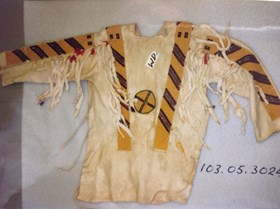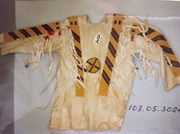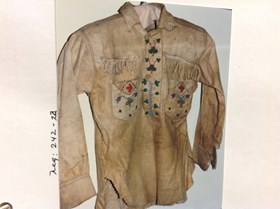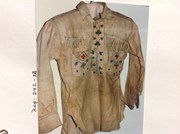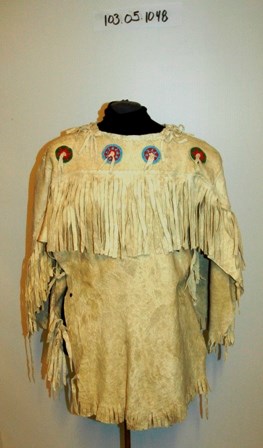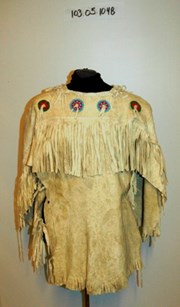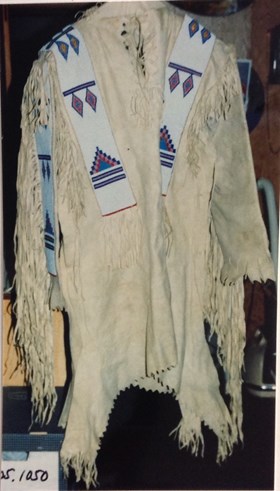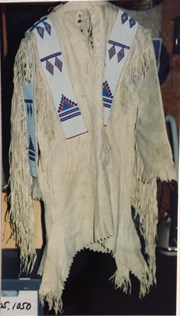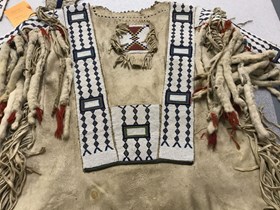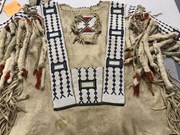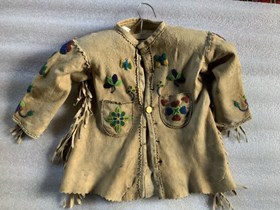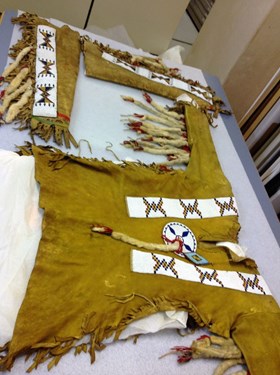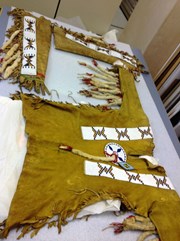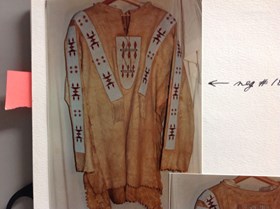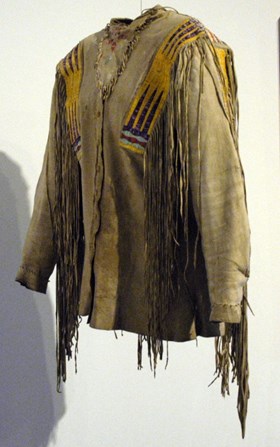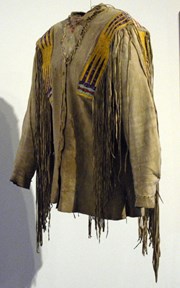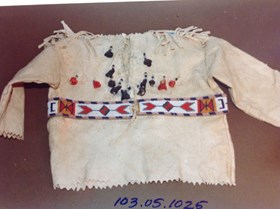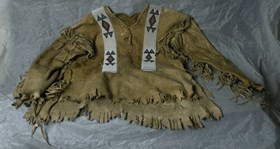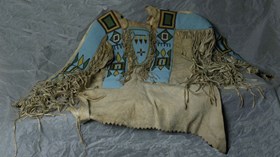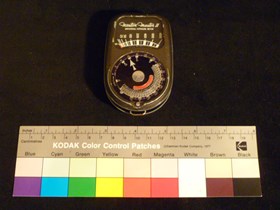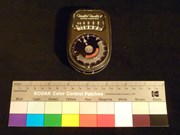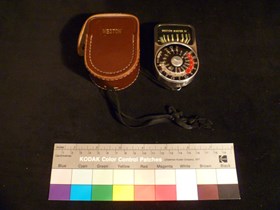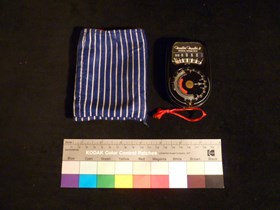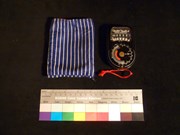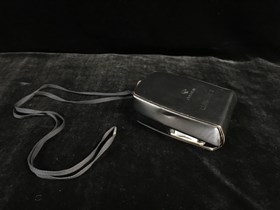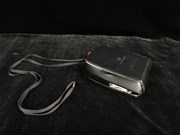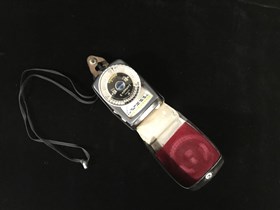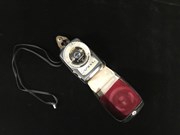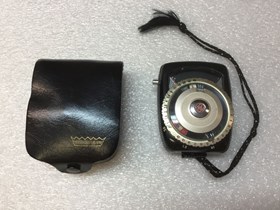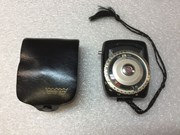Narrow Results By
- Date
- 1930 – 1950
- Material
- skin; glass; metal; fibre
- Catalogue Number
- 103.05.3024
- Description
- Man’s square necked shirt with a metal zipper at the back. The shirt has beadstrips of yellow with repeated diagonal lines in black, red, silver and green. The centre of the shirt front has a yellow beaded medallion with a green border and black and silver cross. There is an ermine and red feath…
1 image
- Title
- Beaded Shirt
- Date
- 1930 – 1950
- Material
- skin; glass; metal; fibre
- Dimensions
- 169.0 x 86.0 cm
- Description
- Man’s square necked shirt with a metal zipper at the back. The shirt has beadstrips of yellow with repeated diagonal lines in black, red, silver and green. The centre of the shirt front has a yellow beaded medallion with a green border and black and silver cross. There is an ermine and red feather fringe along the beadstrips on the arms and down the front. Tag attached: symbol for male, 2 illegible words and “1950” in Pam Knott’s writing (ca. 1996); “moosehide (Pat)” perhaps referring to Pat Brewster.That’s not my writing pk
- Subject
- Indigenous
- regalia
- beadwork
- Credit
- Gift of Catharine Robb Whyte, O. C., Banff, 1979
- Catalogue Number
- 103.05.3024
Images
This material is presented as originally created; it may contain outdated cultural descriptions and
potentially offensive content.
Read more.
- Date
- 1895 – 1910
- Material
- skin; glass; fibre
- Catalogue Number
- 103.05.1066
- Description
- lightly beaded and fringed, long sleeve pullover shirt, front placket and 2 breast pockets beaded in an open floral design, green,light blue, red, blue colours, fringes ca 15.0 x 5.5 sewn above pockets, 2 rows of fringes sewn on back across shoulders, bottom edges picked, hand sewn with black threa…
1 image
- Title
- Beaded Shirt
- Date
- 1895 – 1910
- Material
- skin; glass; fibre
- Dimensions
- 50.0 x 72.5 cm
- Description
- lightly beaded and fringed, long sleeve pullover shirt, front placket and 2 breast pockets beaded in an open floral design, green,light blue, red, blue colours, fringes ca 15.0 x 5.5 sewn above pockets, 2 rows of fringes sewn on back across shoulders, bottom edges picked, hand sewn with black thread.
- Subject
- Indigenous
- beadwork
- regalia
- L.S. Crosby
- Credit
- Gift of Robert Crosby, Banff, 1985
- Catalogue Number
- 103.05.1066
Images
This material is presented as originally created; it may contain outdated cultural descriptions and
potentially offensive content.
Read more.
- Date
- 1930 – 1950
- Material
- skin, deer; glass
- Catalogue Number
- 103.05.1048
- Description
- white buckskin, tied both sides and arms, Phil Moore's, poncho style shirt with fringed head opening, fringes ca. 20.0 along yoke and down back of arms, also at front sides, fringe cut into bottom front and back and at wrists, buckskin thongs sewn on at sides and under arms for closing, 3 rosettes …
1 image
- Title
- Beaded Shirt
- Date
- 1930 – 1950
- Material
- skin, deer; glass
- Dimensions
- 54.0 x 76.0 cm
- Description
- white buckskin, tied both sides and arms, Phil Moore's, poncho style shirt with fringed head opening, fringes ca. 20.0 along yoke and down back of arms, also at front sides, fringe cut into bottom front and back and at wrists, buckskin thongs sewn on at sides and under arms for closing, 3 rosettes ca. 7.0 on front and 4 on shoulder back.
- Subject
- Indigenous
- regalia
- Phillip Moore
- Credit
- Gift of Charles C. Reid, Banff, Alberta, 1986
- Catalogue Number
- 103.05.1048
Images
This material is presented as originally created; it may contain outdated cultural descriptions and
potentially offensive content.
Read more.
- Date
- 1930 – 1950
- Material
- skin, deer; glass
- Catalogue Number
- 103.05.1050
- Description
- long, white buckskin, bead strips, long fringes, front and back single hide each, in irregular shape of animal, long arms sewn on, beadstrips ca 105.0 wide, sewn on over shoulder ca 101.0 long, same design beadstrips ca. 55.0 long sewn on arms, white background with open geometric designs: 2 sets h…
1 image
- Title
- Beaded Shirt
- Date
- 1930 – 1950
- Material
- skin, deer; glass
- Dimensions
- 60.0 x 115.0 cm
- Description
- long, white buckskin, bead strips, long fringes, front and back single hide each, in irregular shape of animal, long arms sewn on, beadstrips ca 105.0 wide, sewn on over shoulder ca 101.0 long, same design beadstrips ca. 55.0 long sewn on arms, white background with open geometric designs: 2 sets handing diamonds from bars, stepped pyramid over 2 bars at bottom, long fringes ca. 65.0 sewn on arms, shorter on shoulder, neck and bottom of bead strips, arm openings have large ca. 3.5 wide strips cut into buckskin, bottom of shirt serrated edge, sides tied together with thongs laced into all sides, serrated neck trim, remnants of green wool.
- Subject
- Indigenous
- beadwork
- Phillip Moore
- Blackfoot
- Credit
- Gift of Charles C. Reid, Banff, Alberta, 1986
- Catalogue Number
- 103.05.1050
Images
This material is presented as originally created; it may contain outdated cultural descriptions and
potentially offensive content.
Read more.
- Date
- 1880 – 1890
- Material
- skin, elk; skin, ermine; hair, sheep; feather; glass; fibre
- Catalogue Number
- 103.05.0008
- Description
- A fringed man's elkskin shirt that has ermine tails attached to the fringe along the sides and sleeves. The shirt is decorated with wide strips of white beadwork with a blue, light blue and gold pattern along the tops of the sleeves and over each shoulder, extending down the front and back of the …
1 image
- Title
- Beaded Shirt
- Date
- 1880 – 1890
- Material
- skin, elk; skin, ermine; hair, sheep; feather; glass; fibre
- Dimensions
- 55.0 (shoulders) x 70.0 cm
- Description
- A fringed man's elkskin shirt that has ermine tails attached to the fringe along the sides and sleeves. The shirt is decorated with wide strips of white beadwork with a blue, light blue and gold pattern along the tops of the sleeves and over each shoulder, extending down the front and back of the shirt, and connected at the bottom with another beaded panel. The back of the shirt has a square beadwork patch surrounded with fringe between the shoulders.
- Credit
- Gift of Pearl Evelyn Moore, Banff, 1979
- Catalogue Number
- 103.05.0008
Images
This material is presented as originally created; it may contain outdated cultural descriptions and
potentially offensive content.
Read more.
- Date
- 1895 – 1910
- Material
- skin, deer; glass
- Catalogue Number
- 103.05.0009
- Description
- A child's deerskin shirt with a front opening. The shirt has fringe along the yoke at the back, and extending down the sleeves and sides of the shirt. There are two breast pockets, and each one has a different flower motif, each done with beads. There are beaded flowers next to the fringe along …
1 image
- Title
- Beaded Shirt
- Date
- 1895 – 1910
- Material
- skin, deer; glass
- Dimensions
- 37.0 (shoulders) x 47.0 cm
- Description
- A child's deerskin shirt with a front opening. The shirt has fringe along the yoke at the back, and extending down the sleeves and sides of the shirt. There are two breast pockets, and each one has a different flower motif, each done with beads. There are beaded flowers next to the fringe along the length of the sleeves.
- Credit
- Gift of Pearl Evelyn Moore, Banff, 1979
- Catalogue Number
- 103.05.0009
Images
This material is presented as originally created; it may contain outdated cultural descriptions and
potentially offensive content.
Read more.
- Date
- 1875 – 1890
- Material
- skin, deer; skin, ermine; hair, sheep; glass
- Catalogue Number
- 103.05.0011
- Description
- A man's deerskin shirt with fringe at the ends of the sleeves. The shirt has strips of beadwork at the shoulders that extend down both the front and back of the garment with a fringe of ermine tails along the length of the outside edge. The background of the beadwork is white with an x-shaped pa…
1 image
- Title
- Beaded Shirt
- Date
- 1875 – 1890
- Material
- skin, deer; skin, ermine; hair, sheep; glass
- Dimensions
- 53.0 (shoulder) x 81.0 cm
- Description
- A man's deerskin shirt with fringe at the ends of the sleeves. The shirt has strips of beadwork at the shoulders that extend down both the front and back of the garment with a fringe of ermine tails along the length of the outside edge. The background of the beadwork is white with an x-shaped pattern of blue, yellow and red. There is a medallion of beadwork in the centre of both the front and back of the shirt, with an ermine tail hanging from the centre of each medallion.
- Credit
- Gift of Pearl Evelyn Moore, Banff, 1979
- Catalogue Number
- 103.05.0011
Images
This material is presented as originally created; it may contain outdated cultural descriptions and
potentially offensive content.
Read more.
- Date
- 1885 – 1900
- Material
- skin, deer; glass; fibre
- Catalogue Number
- 103.05.1023
- Description
- Morning coat length bead-adorned shirt, fringed, notched collar with thongs, slits from bottom to armpits with thong ties, notched bottom edge and sleeves, bead pattern, white background, open geometric design with triangles, diamonds, and crosses of red, mauve and green, strips on sleeves from bre…
1 image
- Title
- Beaded Shirt
- Date
- 1885 – 1900
- Material
- skin, deer; glass; fibre
- Dimensions
- 55.0 x 89.0 cm
- Description
- Morning coat length bead-adorned shirt, fringed, notched collar with thongs, slits from bottom to armpits with thong ties, notched bottom edge and sleeves, bead pattern, white background, open geometric design with triangles, diamonds, and crosses of red, mauve and green, strips on sleeves from breast over shoulder to lower back (canvas backed), fringes on ends, buckskin backed swatches, solarplexus, back (fringed).
- Subject
- Indigenous
- clothing
- regalia
- beadwork
- Credit
- Gift of Pearl Evelyn Moore, Banff, 1969
- Catalogue Number
- 103.05.1023
Images
This material is presented as originally created; it may contain outdated cultural descriptions and
potentially offensive content.
Read more.
- Date
- 1880 – 1900
- Material
- skin; quill ; fibre
- Catalogue Number
- 103.05.1024
- Description
- Fringed buckskin shirt with porcupine quills, collarless, rounded beige buttons, (12) green and pink floral quill gorget, same on back attached at neck, quill strips, yellow background, opposed long purple spear shapes, above and below wavy lines, turquoise, purple, red, yellow, with long buckskin …
1 image
- Title
- Beaded Shirt
- Date
- 1880 – 1900
- Material
- skin; quill ; fibre
- Dimensions
- 52.5 x 81.8 cm
- Description
- Fringed buckskin shirt with porcupine quills, collarless, rounded beige buttons, (12) green and pink floral quill gorget, same on back attached at neck, quill strips, yellow background, opposed long purple spear shapes, above and below wavy lines, turquoise, purple, red, yellow, with long buckskin fringes on edges, strips on sleeves and from breast across shoulder to lower back, sleeves cuffed with notched edge.
- Subject
- Indigenous
- regalia
- clothing
- quillwork
- Credit
- Gift of Unknown, 1968
- Catalogue Number
- 103.05.1024
Images
This material is presented as originally created; it may contain outdated cultural descriptions and
potentially offensive content.
Read more.
- Date
- 1930 – 1950
- Material
- skin, deer; glass; fibre; bone
- Catalogue Number
- 103.05.1025
- Description
- Buckskin beaded belt, red and blue knuckle bone, fringed shoulder with brown/blue bead strip, pinked sleeves, collar and shirt tail, stitched on belt below armpit, canvas back with pin/blue striped edge, triangle, diamond and geometric motifs multi-coloured, white background, knuckle bone pieces, b…
1 image
- Title
- Beaded Shirt
- Date
- 1930 – 1950
- Material
- skin, deer; glass; fibre; bone
- Dimensions
- 36.0 x 36.0 cm
- Description
- Buckskin beaded belt, red and blue knuckle bone, fringed shoulder with brown/blue bead strip, pinked sleeves, collar and shirt tail, stitched on belt below armpit, canvas back with pin/blue striped edge, triangle, diamond and geometric motifs multi-coloured, white background, knuckle bone pieces, blue along edge of collar, red on breast, hung from blue/white large tube bead strands.
- Subject
- Indigenous
- regalia
- beadwork
- children
- Credit
- Gift of Unknown, 1968
- Catalogue Number
- 103.05.1025
Images
This material is presented as originally created; it may contain outdated cultural descriptions and
potentially offensive content.
Read more.
- Date
- 1920 – 1940
- Material
- skin; glass; metal
- Catalogue Number
- 103.05.0082
- Description
- A man's buckskin shirt cut from a single piece of buckskin and laced at the sides, edged head cutout and fitted sleeves. The laces draw through from the front to the back and then hang down, becoming part of the fringe, bottom edges are pinked. Other parts, beadwork strips on arms, have fringes han…
1 image
- Title
- Beaded Shirt
- Date
- 1920 – 1940
- Material
- skin; glass; metal
- Dimensions
- 55.0 x 72.0 cm
- Description
- A man's buckskin shirt cut from a single piece of buckskin and laced at the sides, edged head cutout and fitted sleeves. The laces draw through from the front to the back and then hang down, becoming part of the fringe, bottom edges are pinked. Other parts, beadwork strips on arms, have fringes hanging from them. Two white beadwork bands are sewn to the shirt coming up the chest, across the shoulders and going down the back, and two like bands running the length of the arms. The beadwork is principally white with brass bead diamonds and triangles surrounded by burgundy and blue outlines.
- Subject
- Indigenous
- beadwork
- regalia
- Credit
- Gift of Catharine Robb Whyte, O. C., Banff, 1979
- Catalogue Number
- 103.05.0082
Images
This material is presented as originally created; it may contain outdated cultural descriptions and
potentially offensive content.
Read more.
- Date
- 1920 – 1935
- Material
- skin; glass; fibre
- Catalogue Number
- 103.05.0084
- Description
- A white buckskin tunic cut from a single hide, the edges of the hide fringed out in twisted fringe, open at sides (no thongs), and the yoke edged for strength, arms inset at shoulders. White ground beadstrips running down chest over shoulders and down back, beaded on canvas, and beadstrips running …
1 image
- Title
- Beaded Shirt
- Date
- 1920 – 1935
- Material
- skin; glass; fibre
- Dimensions
- 57.0 x 71.0 cm
- Description
- A white buckskin tunic cut from a single hide, the edges of the hide fringed out in twisted fringe, open at sides (no thongs), and the yoke edged for strength, arms inset at shoulders. White ground beadstrips running down chest over shoulders and down back, beaded on canvas, and beadstrips running down arms. Ermine trims along arms and down back. Beadstrips of white with stepped squares of orange, dusty rose, and alternated with bent crosses (swastikas) in green.
- Subject
- Indigenous
- beadwork
- regalia
- Credit
- Gift of Catharine Robb Whyte, O. C., Banff, 1979
- Catalogue Number
- 103.05.0084
Images
This material is presented as originally created; it may contain outdated cultural descriptions and
potentially offensive content.
Read more.
- Date
- 1925 – 1935
- Material
- skin; glass
- Catalogue Number
- 103.05.0085
- Description
- A man's shirt, open along the sides, with long sleeves and notched edge at bottom which is longer at the sides than in the middle. Very thin white buckskin with extremely long fringes along length of sleeves. Bead strips along length of sleeves and over shoulders extending half way down front and b…
1 image
- Title
- Beaded Shirt
- Date
- 1925 – 1935
- Material
- skin; glass
- Dimensions
- 76.0 x 53.0 x 51.0 cm
- Description
- A man's shirt, open along the sides, with long sleeves and notched edge at bottom which is longer at the sides than in the middle. Very thin white buckskin with extremely long fringes along length of sleeves. Bead strips along length of sleeves and over shoulders extending half way down front and back, plus beaded triangular panel in centre of back and another in front forming flap to cover front slit opening at neck. All beadwork on light blue background, motif on sleeve strip of rectangle outlined in green, then blue, then yellow, then red, and flanked on each end with yellow diamond and green triangles outlined in dark blue. Similar rectangle motif, different colour sequencing outlining rectangle, at each end of shoulder strip, with large green square outlined with blue, then red atop shoulder and green diamond with red square outlined in white at its centre and a blue toothed rake at the other end, hanging on either side of the shoulder. Triangular panels on front and back have red bar at top with three yellow and red diamonds hanging from it, and a red cross with yellow square at centre beneath. Yellow ochre bands set in from edge along sides of triangle are joined by a green band along the shorter, top side. The two long sides of the panel are surrounded by short fringes with very long fringes at the point at the bottom. The front triangular panel ties across the slit opening at the front of the neck with buckskin ties through two holes through the buckskin, the opposite side being sewn to the shirt. The open sides of the shirt tie together with buckskin things.
- Subject
- Indigenous
- beadwork
- regalia
- Credit
- Gift of Catharine Robb Whyte, O. C., Banff, 1979
- Catalogue Number
- 103.05.0085
Images
This material is presented as originally created; it may contain outdated cultural descriptions and
potentially offensive content.
Read more.
Exposure Meter
https://archives.whyte.org/en/permalink/artifact104.41.1118
- Date
- 1888
- Material
- metal; paint; plastic
- Catalogue Number
- 104.41.1118
- Description
- Hand held exposure/light meter made by Weston Electrical Instrument Company in a grey metal finish. Along both sides of the meter are a series of protruding lines that allow one to safely grip the object. At the bottom of the artifact there is a metal hook, which would have allowed a string to be a…
1 image
- Title
- Exposure Meter
- Date
- 1888
- Material
- metal; paint; plastic
- Dimensions
- 2.0 x 6.0 x 9.5 cm
- Description
- Hand held exposure/light meter made by Weston Electrical Instrument Company in a grey metal finish. Along both sides of the meter are a series of protruding lines that allow one to safely grip the object. At the bottom of the artifact there is a metal hook, which would have allowed a string to be attached like on the other Weston meter’s owned by Nicholas. There is also no longer a case to protect this particular object. In the top of the exposure meter there is a clear plastic covering. Along the very top there us the name of the manufacturer in white cursive lettering that reads “Weston Master II” and written underneath in capital letters “UNIVERSAL EXPOSURE METER.” Below this is the light scale where the value of the scene would be indicated. The scale contains the values “0” “25” “50” “100” “200” “400” “800” “1600,” which means that the two values on this instrument are calibrated 0-50 and 0-1600. (candles per square foot.)Below there is a circular face with several figures and a dial that turns/rotates. The outside row of figures on the exposure control dial represents the light value settings and corresponds to the light values on the light scale. Below the round dial there is a tiny circular button that is used to set the exposure control dial for film speed. As the dial turns it reveals the “EMULSION SPEED” with a red baize finish that has become worn throughout its life. The row of figures at the bottom of the top dial is the f/stop values and has an “f” to make this more apparent for the user. The row of figures directly below the f/stop settings are the shutter speeds. After setting the exposure control dial to the light value obtained on the light scale, any of the combinations of f/stop and shutter speed directly opposite each other are correct. On the rear of the meter there is a black plastic covering that contains several circular cut outs that are called a hir.ged baffle. This can be swung open (against the case) using the gold latch, which clips into a tiny hole or socket when the user wishes it to be closed. When opened the light sensitive photo cell is directly beneath this baffle and contains several protruding circles. When the baffle is open, the scale range is 0-50; when the baffle is closed, the scale range is 0-1600. Below there is an oval shaped face with extensive information that is held in place with two small screws on both the viewer left and right side. There is silver lettering on a black background that reads “WESTON ELEC. INST. CORP.” “NEWARK, N.J., U.S.A.” A silver backing separates the patent information and has black writing that reads “MODEL 735” on the viewer left side. On the viewer right side the number “7454510” is engraved. In the middle there is a gold-coloured screw with the words “ZERO CORRECTOR” written in black. Below this there is the patent information; “U.S. PATENTS” “2,274,441” “2,073,790” “2,346,555” “2,137,466” “2,463,770.” Below these numbers are the “FOREIGN PATENTS” “FRENCH 862,770” “BRITISH 531,996” “CAN. 347,085” “CAN. 411,975” At the very bottom underneath there is the manufacturer’s location; “MADE IN U.S.A.”
- Subject
- photography
- Nick Morant
- Credit
- Gift of Nicholas Morant, Banff, 2006
- Catalogue Number
- 104.41.1118
Images
This material is presented as originally created; it may contain outdated cultural descriptions and
potentially offensive content.
Read more.
- Date
- 1888
- Material
- leather; metal; nylon; plastic; thread; paint
- Catalogue Number
- 104.41.1119 a-b
- Description
- Hand held light meter in a pear shape with a stainless steel body and leather case. Along both sides of the meter are a series of protruding lines that allow one to safely grip the object. On the viewer right there is a pointer lock, which is locked when positioned upwards and released when positio…
1 image
- Title
- Exposure Meter
- Date
- 1888
- Material
- leather; metal; nylon; plastic; thread; paint
- Dimensions
- 2.0 x 5.0 x 9.0 cm
- Description
- Hand held light meter in a pear shape with a stainless steel body and leather case. Along both sides of the meter are a series of protruding lines that allow one to safely grip the object. On the viewer right there is a pointer lock, which is locked when positioned upwards and released when positioned downward. At the bottom of the artifact there is a metal hook, which has a black string running through. In the top of the light meter there is clear plastic covering. Written in capital letters is “WESTON MATER IV” above the light scale. The lights scale contains the numbers “0” “25” “50” “100” “200” “400” “800” “1600,” which means that the 2 values calibrated on this instrument are 0-50 and 0-1600.Below there is another light scale in the form of a circular face with several figures and a dial that turns/rotates. The dial on the outside has a series of protruding lines to make movement easier and contains a row of figures. This dial controls the lens aperture (f/stop) scale and has a series of values representing the focal length of the lens; “1” “1.4” “2” “2.8” “4” “5.6”. On the same dial there is also the letters “EVS,” which stands for the exposure value setting with a cut out window that reveals the EVS values. Working in a clockwise direction (on the same dial) there is also the letters “U,” “A with “1/2” over top,” an enclosed arrow that is known as the normal arrow, a “C” with “2x” on top of it, and a “0”. As this dial is turned it reveals a partly red baize and black numbers on a silver background that represents the shutter speeds in fractions of seconds. The inside dial has a series of light scale values and an exposure index window that line up with the “U,” “A,” normal arrow, “C,” and “0.” On the opposite side of the exposure index window is the exposure index knob. On the rear of the meter there is a black plastic covering that contains several circular cut outs that are called a hir.ged baffle. This can be swung open (against the case) using the gold latch, which clips into a tiny hole or socket when the user wishes it to be closed. When opened the light sensitive photo cell is directly beneath this baffle and contains several protruding circles. When the baffle is open, the scale range is 0-50; when the baffle is closed, the scale range is 0-1600. Below there is an oval shaped face with extensive information that is held in place with two small screws on both the viewer left and right side. There is black lettering on a silver background that reads “UNIVERSAL EXPOSURE METER” “MODEL 745” SER.W” and “107522” engraved. Below the manufacturer information is listed; “DAYSTROM. INCORPORATED” “WESTON INSTRUMENTS DIVISION”. “NEWARK. N.J.. U.S.A.” In the middle there is a gold-coloured screw with the words “ZERO CORRECTOR” written in black. On the viewer left side of the zero corrector there is patent information; “U.S. PATENTS” “2463770” and on the viewer right side “FOREIGN PATS” “CAN. 411975”. At the very bottom on either side of a circular cut out are “ASA” and “K=1.0” written. Underneath “MADE IN JAPAN” has also been written.There is also a brown leather case with this object. The front has “WESTON” written in gold letters. On the viewer left there is a brown button that allows the case to be opened or fastened shut. The leather has been stitched together with light brown thread that is visible. The bottom of the case has an opening for the black string to be strung through so that the light meter and case are attached. On the rear there is a brown leather strap stitched.
- Subject
- photography
- Nick Morant
- Credit
- Gift of Nicholas Morant, Banff, 2006
- Catalogue Number
- 104.41.1119 a-b
Images
This material is presented as originally created; it may contain outdated cultural descriptions and
potentially offensive content.
Read more.
- Date
- 1888
- Catalogue Number
- 104.41.1120 a-b
- Description
- Hand held light meter in a pear shape with a stainless steel body and leather case. Along both sides of the meter are a series of protruding lines that allow one to safely grip the object. At the bottom of the artifact there is a metal hook, which has a red string running through.There is a clear p…
1 image
- Title
- Exposure Meter
- Date
- 1888
- Description
- Hand held light meter in a pear shape with a stainless steel body and leather case. Along both sides of the meter are a series of protruding lines that allow one to safely grip the object. At the bottom of the artifact there is a metal hook, which has a red string running through.There is a clear plastic covering located at the top of the meter. Written in cursive letters is the company name “WESTON MATER II”. Underneath this written in capital letters is “UNIVERSAL EXPSOURE METER”. The light scale underneath contains the numbers “0” “25” “50” “100” “200” “400” “800” “1600,” which means that the 2 values calibrated on this instrument are 0-50 and 0-1600. Underneath the scale the word “Light” is present. Below there is another light scale in the form of a circular face with several figures and a dial that turns/rotates. The outside row of figures on the exposure control dial represents the light value settings and corresponds to the light values on the light scale at the top. The row of figures at the bottom of the top dial is the f/stop values and has an “f” to make this more apparent for the user.. On the same dial there is silver letters that have a line that correspond to the figures on the outside dial; “U,” “A with “1/2” underneath,” an arrow that is known as the normal arrow, a “C” with “2x” below it, and a “0”. As this dial is turned it reveals a partly red baize and the emulsion speed, which is self-evident as the words “EMULSION SPEED” are present. The row of figures directly below the f/stop settings are the shutter speeds. The outside row of figures is the light values, which is apparent as the word “LIGHT” with an arrow points to these values. After setting the exposure control dial to the light value obtained on the light scale, any of the combinations of f/stop and shutter speed directly opposite each other are correct. Below the round dial there is a tiny circular button that is used to set the exposure control dial for film speed.On the rear of the meter there is a black plastic covering that contains several circular cut outs that are called a hir.ged baffle. This can be swung open (against the case) using the gold latch, which clips into a tiny hole or socket when the user wishes it to be closed. When opened the light sensitive photo cell is directly beneath this baffle and contains several protruding circles. When the baffle is open, the scale range is 0-50; when the baffle is closed, the scale range is 0-1600. Below there is an oval shaped face with extensive information that is held in place with two small screws on both the viewer left and right side. There is silver lettering on a black background that reads “WESTON ELEC. INST. CORP.” “NEWARK, N.J., U.S.A.” A silver backing separates the patent information and has black writing that reads “MODEL 735” on the viewer left side; “No” is present in the middle; “8284703” is engraved on the viewer right side. In the middle there is a brass screw with the words “ZERO CORRECTOR” written in black around its circumference. On the viewer left side of the zero corrector is the patent information; “U.S. PATENTS” “1,779,574” “1,982,406” “2,073,790” and on the viewer right side continued patent information “U.S. PATENTS” “2,137,466” “2,274,441” “2,346,555”. Below these numbers are the “FOREIGN PATENTS” “FRENCH 862,770” “BRITISH 531,996” “CAN. 347,085” “CAN. 411,975” At the very bottom underneath there is the manufacturer’s location; “MADE IN U.S.A.” written in black on a silver background.There is also a blue case with white stripes and a red inner lining that would be used to protect the case. This would not have been originally sold with the exposure meter and was most likely hand made in an effort to protect the meter. Blue stitches hold the fabric together and are visible.
- Subject
- photography
- Nick Morant
- Credit
- Gift of Nicholas Morant, Banff, 2006
- Catalogue Number
- 104.41.1120 a-b
Images
This material is presented as originally created; it may contain outdated cultural descriptions and
potentially offensive content.
Read more.
- Date
- 1933 – 1949
- Material
- plastic; paint; leather; metal; fabric
- Catalogue Number
- 104.41.1123 a-b
- Description
- (a)Gossen Lunasix exposure and colour meter in a pear shape with leather case. The light meter device measures the amount of light that is appropriate to achieve the proper exposure, indicating for the users which shutter speed and f-number should be selected. Along the top of the exposure meter in…
1 image
- Title
- Exposure Meter
- Date
- 1933 – 1949
- Material
- plastic; paint; leather; metal; fabric
- Dimensions
- (a)2.5; (b)04.5 x (a)6.5; (b)7.5 x (a)11.5; (b)12.0 cm
- Description
- (a)Gossen Lunasix exposure and colour meter in a pear shape with leather case. The light meter device measures the amount of light that is appropriate to achieve the proper exposure, indicating for the users which shutter speed and f-number should be selected. Along the top of the exposure meter in the viewer left corner is a white bulb-like part next to an open circular window that measures the amount of light present in the scene. When the converter slide, located along the viewer right side, is moved to the right and clicked into position the round window is open and ready to read the scene. At the top, on the face of the meter, the light measurement (scale) is present. This shows how much light is present in the scene and directly relates to the remaining scales on the meter. Below the light scale is a plexiglass film-speed setting disc with grooves that allow the operator to easily move the dial. In the middle of the dial there is the Lunasix manufacturer symbol. On viewer left side of this emblem is the DIN exposure index of the film in use; on the proper right side of this emblem is the ASA exposure index of the film in use. By moving the dial one adjusts the film-speed setting, which is indicated in the DIN and ASA boxes, whereby the index number is lined up against the triangular white marker in the respective window. A manual would have originally been sold with the object giving a more comprehensive overview of the film-speed table with a technical appendix. On the rear of the object in the viewer right corner one will see the correct position of the 2 batteries indicated through a tiny diagram. Below this is a metal battery chamber. Below this are the words “2 Batt. Mallory” “PX 625 o. PX 13”. To the viewer left of this writing is the ridged slide used for battery testing. Above the ridged slide are the words “Batt. Contr.” with a solid arrow below. Below the battery information is the table of footcandle (LUX) equivalents. In the middle of the table is the zero adjustable screw with an arrow pointing in both directions. AT the very bottom painted on the surface is the location of manufacturing; “GERMANY (WEST)” above a cutout window revealing the patent number; “4D01673”. (b) There is also a black leather case with the object. The inside of the case has gray suede lining, which would have helped avoid scratching and marking of the meter. The case has been carefully designed to retrofit the meter, which is apparent through the tiny leather strap present when the case is opened. These designs allow the object to be formly held into place further safeguarding it. At the bottom of the case there is a black button that allows the case to be opened and fastened shut. When the case is fastened shut, the name of the manufacturer “Gossen” appears imprinted and is upside down. Below this, also upside down, “LUNASIX 3” has been applied in silver ink. Along the viewer right side the case has a cutout that perfectly fit the converter slide. On the rear “MADE IN GERMANY” appears in a receded box with protruding lettering. The bottom of the case, where the button is located, contains an opening for the black string to be strung through. The string, which has been tied to the exposure meter, measures 49.0 cm and has a metal piece holding the ends of the string in place. This would have given the user greater security when working with the exposure meter.
- Subject
- photography
- Nick Morant
- Credit
- Gift of Nicholas Morant, Banff, 2006
- Catalogue Number
- 104.41.1123 a-b
Images
This material is presented as originally created; it may contain outdated cultural descriptions and
potentially offensive content.
Read more.
- Date
- 1933 – 1949
- Material
- plastic; metal; leather; paint; fabric
- Catalogue Number
- 104.41.1124 a-b
- Description
- (a)Gossen Lunasix exposure and colour meter in a pear shape with leather case. The light meter device measures the amount of light that is appropriate to achieve the proper exposure, indicating for the users which shutter speed and f-number should be selected. Along the top of the exposure meter in…
1 image
- Title
- Exposure Meter
- Date
- 1933 – 1949
- Material
- plastic; metal; leather; paint; fabric
- Dimensions
- (a)2.5; (b)04.5 x (a)6.5; (b)7.5 x (a)11.5; (b)12.0 cm
- Description
- (a)Gossen Lunasix exposure and colour meter in a pear shape with leather case. The light meter device measures the amount of light that is appropriate to achieve the proper exposure, indicating for the users which shutter speed and f-number should be selected. Along the top of the exposure meter in the viewer left corner is a white bulb-like part next to an open circular window that measures the amount of light present in the scene. When the converter slide, located along the viewer right side, is moved to the right and clicked into position the round window is open and ready to read the scene. At the top, on the face of the meter, the light measurement (scale) is present. This shows how much light is present in the scene and directly relates to the remaining scales on the meter. Below the light scale is a plexiglass film-speed setting disc with grooves that allow the operator to easily move the dial. In the middle of the dial there is the Lunasix manufacturer symbol. On viewer left side of this emblem is the DIN exposure index of the film in use; on the proper right side of this emblem is the ASA exposure index of the film in use. By moving the dial one adjusts the film-speed setting, which is indicated in the DIN and ASA boxes, whereby the index number is lined up against the triangular white marker in the respective window. A manual would have originally been sold with the object giving a more comprehensive overview of the film-speed table with a technical appendix. On the rear of the object in the viewer right corner one will see the correct position of the 2 batteries indicated through a tiny diagram. Below this is a metal battery chamber. Below this are the words “2 Batt. Mallory” “PX 625 o. PX 13”. To the viewer left of this writing is the ridged slide used for battery testing. Above the ridged slide are the words “Batt. Contr.” with a solid arrow below. Below the battery information is the table of footcandle (LUX) equivalents and is only for incident light. In the middle of the table is the zero adjustable screw with an arrow pointing in both directions. AT the very bottom painted on the surface is the location of manufacturing; “GERMANY (WEST)” above a cutout window revealing the patent number; “289337”. (b) There is also a black leather case with the object. The inside of the case has gray suede lining, which would have helped avoid scratching and marking of the meter. Some of this material must have worn away throughout the life of the case, as a red section of suede has been added to the case. The case has been carefully designed to retrofit the meter, which is apparent through the tiny leather strap present when the case is opened. These designs allow the object to be firmly held into place further safeguarding it. At the bottom of the case there is a black button that allows the case to be opened and fastened shut. When the case is fastened shut, the name of the manufacturer is protruding and reads: “GOSSEN”, which appears in the middle of a recessed circle. Below this, also upside down, “LUNASIX 3” is imprinted in protruding letters. Along the viewer right side the case has a cutout that perfectly fit the converter slide. On the rear “MADE IN GERMANY” appears in a receded box with protruding lettering. The bottom of the case, where the button is located, contains an opening for a black string to be strung through, which is also attached to the meter. The string, which has been tied to the bottom of the exposure meter, measures 49.0 cm and has a metal piece holding the ends of the string in place. This would have given the user greater security when working with the exposure meter.
- Subject
- Nick Morant
- Credit
- Gift of Nicholas Morant, Banff, 2006
- Catalogue Number
- 104.41.1124 a-b
Images
This material is presented as originally created; it may contain outdated cultural descriptions and
potentially offensive content.
Read more.
- Date
- n.d.
- Material
- metal; paper; plastic
- Catalogue Number
- 104.41.1305 a-e
- Description
- a) open face pocket watch shaped meter with a metallic body and two dials showing through the cover glass; milled edge rings that revolve for exposure adjustment; small orange glass disc mounted on top of the cover glass to protect the sensitive paper segment; label at the centre of the instrument’…
1 image
- Title
- Exposure Meter
- Date
- n.d.
- Material
- metal; paper; plastic
- Dimensions
- 2.0 x 5.5 x 8.0 cm
- Description
- a) open face pocket watch shaped meter with a metallic body and two dials showing through the cover glass; milled edge rings that revolve for exposure adjustment; small orange glass disc mounted on top of the cover glass to protect the sensitive paper segment; label at the centre of the instrument’s face, in black print against a white background: “Wynne’s “Infallible” Exposure Meter”; smallest concentric dial is labelled: “ACTINOMETER / TIME AND EXPOSURE IN SECONDS OR MINUTES.”; the calibration ranges from 1/128 to 64; the largest concentric dial is labelled: “DIAPHRAGMS AND PLATE SPEED NOS” and its calibration ranges from F4 to F362; on the back, “EXCEPTIONAL SUBJECTS” exposures are engraved: “SEA AND SKY 1/10 / DITTO WITH SHIPS 1/4 / SNOW SCENES 1/4 / WHITE STATUARY 1/4 / LIGHT FOREGROUND 1/2 / PORTRAITS NEAR CAMERA 1 1/2 / DARK OBJECTS DITTO 2”; a curly bracket on the list right side is labelled vertically: “NORMAL EXPOSURE”b) original rectangular golden tin case with red print label on lid: “WYNNE’S “INFALLIBLE” / PHOTOGRAPHIC / EXPOSURE METER /AN UNERRING GUIDE TO / THE CORRECT EXPOSURE REQUIRED FOR EVERY SPEED OF PLATE, ON EVERY KIND OF SUBJECT, AND UNDER EVERY CONDITION OF LIGHT / THE “INFALLIBLE” / EXPOSURE METER COMPANY, / WREXHAM.”; tiny hole pierced in the viewer’s right hand side with a golden metallic piece of wire poking through, held in place by loops formed at each endc) 32-pages long instruction manual with green cover; text on front cover in black print placed inside a wiggly rectangular frame: “The true progress of Invention is towards simplicity.” / What the watch is to find the correct time of day, / The “Infallible” Exposure Meter is to find the correct time of exposure. / You set the scale, it does the rest. / WYNNE’S “Infallible” / Photographic Exposure Meter / IS AN UNERRING GUIDE TO / The correct exposure required for every speed of plate on every kind of subject, and under every condition of light. / The “Infallible” / Exposure Meter Company, Wrexham.”; sections include the “four conditions which govern exposure”: “ 1- The intensity of the light which illuminates the subject. / 2- The Diaphragm or Stop employed. / 3- The character of the subject to be photographed. / 4- The sensitiveness of the plate used.” followed by: “TO CALCULATE THE CORRECT EXPOSURE / PHOTOGRAPHING EXCEPTIONAL SUBJECTS / PLATE SPEED NUMBERS / INSTANTANEOUS PHOTOGRAPHS / INTERIORS / ENLARGEMENTS / SIMPLICITY OF INSTRUMENT / DIRECTIONS AS TO USE OF METER”d) square red paper envelope; text in black print on front: “Rapid Deadmatch Paper” underlined, followed by description: “New and Perfected Sensitive Paper for Wynne’s Infallible Exposure Meter. / Price 6d Per Packet. / Open only in a Weak or Artificial Light. / Remove contents and put in bottom of Meter Case. / THE INFALLIBLE EXPOSURE METER CO., / Wrexham.”; contains 4 circles of sensitive papere) yellowed car leaflet folded in three; text on front: “May, 1913. / Latest List of SPEED PLATES” with drawn illustration of the exposure meter followed by list of plate brand and their corresponding F-stop
- Subject
- Nicholas Morant
- photography
- Credit
- Gift of Nicholas Morant, Banff, 2006
- Catalogue Number
- 104.41.1305 a-e
Images
This material is presented as originally created; it may contain outdated cultural descriptions and
potentially offensive content.
Read more.
Exposure Meter
https://archives.whyte.org/en/permalink/artifact104.41.0141
- Date
- 1955 – 1958
- Material
- metal; plastic; leather; fabric
- Catalogue Number
- 104.41.0141
- Description
- A General Electric Exposure Meter (type PR-3) in a black leather pouch. The meter has several dials on the front in order to set the exposure, a silver metal button on the left-hand side, a brief instruction plate attached to the back, and a black and gold fabric cord attached to the bottom. It is …
1 image
- Title
- Exposure Meter
- Date
- 1955 – 1958
- Material
- metal; plastic; leather; fabric
- Dimensions
- 3.4 x 6.7 x 8.2 cm
- Description
- A General Electric Exposure Meter (type PR-3) in a black leather pouch. The meter has several dials on the front in order to set the exposure, a silver metal button on the left-hand side, a brief instruction plate attached to the back, and a black and gold fabric cord attached to the bottom. It is mostly made of black plastic - the dials on the front and instruction plate on the back are both metal. The leather pouch has a front flap that snaps closed at the bottom and is mostly open on the inside so as to access the meter’s dials - there are openings on the left-hand side and the bottom for the button and cord. In the bottom right corner of the front flap is an embossed gold crown.
- Credit
- Gift of Nicholas Morant, Banff, 2006
- Catalogue Number
- 104.41.0141
Images
This material is presented as originally created; it may contain outdated cultural descriptions and
potentially offensive content.
Read more.

